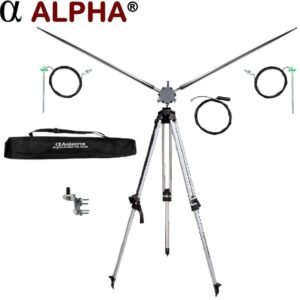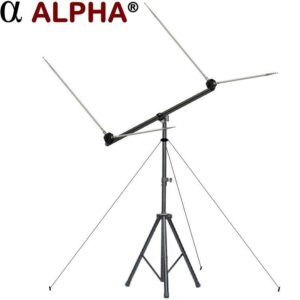The HexTenna is a resonant High-Frequency (HF) antenna. This antenna system is designed to efficiently transmit or receive electromagnetic waves at a specific frequency. Its’ resonance occurs when the electrical length of the telescopic whips matches the wavelength of the radio frequency it is intended to operate at. Here are some key aspects of what happens when you deploy and use the resonant HF HexTenna:
- Efficiency: The resonant HexTenna antenna is more efficient than non-resonant ones because it effectively converts electrical energy into electromagnetic waves at the desired frequency. This efficiency is crucial for maximizing the range and performance of the antenna.
- Impedance Matching: The resonant HexTenna antenna exhibits a near-ideal impedance match at the resonant frequency. This is especially true as the angle of one element in relation to the other provide a near perfect 50-ohms. This V-Dipole design is inherently better than a standard dipole. This is because the standard dipole has an approximate impedance of 72-ohms when one element is positioned 180 degrees from the other. This means that the impedance of the HexTenna antenna closely matches the impedance of the transmission line and the connected radio equipment, reducing signal reflections and improving power transfer.
- Narrow Bandwidth: Resonant antennas typically have a narrow bandwidth, meaning they work well within a specific frequency range centered around their resonant frequency. This can be an advantage if you want to operate at a specific frequency, but it may be a limitation if you need to cover a broader range of frequencies. To overcome this limitation, the HexTenna uses telescopic whips that have a large enough diameter to provide bandwidth that is very usable without having to retune with every time you change frequency.
- Tuning: Tuning a resonant antenna involves adjusting its physical dimensions to achieve resonance at the desired frequency. To make this an easy process, telescopic whips are extended or retracted to tune the HexTenna.
- Propagation: It can be crucial to maximize ERP to enable effective propagation to occur. This is the primary function of the resonant HF HexTenna antenna, which provides efficient signal propagation for reliable communication. This is especially turn because atmospheric conditions and ionospheric effects play a significant role in HF communications.
Keep in mind that the effectiveness of an antenna is not solely determined by resonance. Factors such as the antenna’s location, height above ground, and the surrounding environment also play important roles in its performance. Additionally, while the resonant HexTenna antenna is often preferred for maximum ERP, there are cases where non-resonant antennas, such as broadband antennas, may be more suitable for simultaneously covering a wider frequency range (spread spectrum communications for example).
-
2-40M+440 HF VHF UHF Antenna (HexTenna Deluxe)$600.00Rated 5.00 out of 5 based on 32 customer ratings
-
2-20M HF VHF Antenna (Yagi Deluxe)$800.00Rated 5.00 out of 5 based on 4 customer ratings



